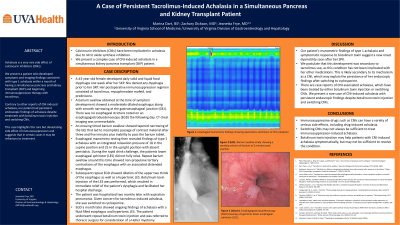Monday Poster Session
Category: Esophagus
P1929 - A Case of Persistent Tacrolimus-Induced Achalasia in a Simultaneous Pancreas and Kidney Transplant Patient
Monday, October 23, 2023
10:30 AM - 4:15 PM PT
Location: Exhibit Hall

Has Audio

Jeanetta Frye, MD
Universtify of Virginia
Charlottesville, VA
Presenting Author(s)
Marina Dart, BS1, Zachary Dickson, MD1, Jeanetta Frye, MD2
1University of Virginia, Charlottesville, VA; 2Universtify of Virginia, Charlottesville, VA
Introduction: Calcineurin Inhibitors (CNIs) have been implicated in achalasia likely due to nitric oxide synthase inhibition. We present a complex case of CNI-induced achalasia in a simultaneous kidney pancreas transplant (SKP) patient.
Case Description/Methods: A 43 year old female developed daily solid and liquid food dysphagia one week after her SKP. She denied any dysphagia prior to transplant. Her postoperative immunosuppression regimen consisted of tacrolimus, mycophenolate mofetil and prednisone. Esophagogastroduodenoscopy (EGD) showed no stricture but did show a dilated esophagus and hypertonic LES (lower esophageal sphincter). CT chest imaging was unremarkable. An ensuing timed barium swallow showed tapered narrowing of the GEJ that led to incomplete passage of contrast material after five minutes. Esophageal manometry testing subsequently revealed findings of type I achalasia with an integrated relaxation pressure of 18mmHg in the supine position and absent peristalsis. Botulinum toxin injection of the hypertonic lower esophageal sphincter (LES) was performed during a subsequent EGD, which led to immediate relief of her dysphagia and facilitated the patient’s hospital discharge. She was hospitalized two months later with aspiration pneumonia. Given concern for tacrolimus-induced achalasia, she was switched to cyclosporine. A repeat EGD a month later showed ongoing findings of achalasia with a fluid filled esophagus and hypertonic LES. As a result, she was referred to thoracic surgery for consideration of a Heller myotomy.
Discussion: Our patient’s manometric findings of type I achalasia and symptomatic response to botulinum toxin suggest a new onset dysmotility soon after her SPK. We postulate that this development was secondary to tacrolimus use, as this condition has not been implicated with her other medications. This is likely secondary to its mechanism as a CNI, which likely explains the persistence of her endoscopic findings with cyclosporine use. There are case reports of CNI-associated achalasia, which have been treated by either botulinum toxin injection or switching CNIs. We present a rare case of CNI-induced achalasia with persistent endoscopic findings.
1 Campos, Marilia, and Robert Matlock. “Endoscopic Botulinum Toxin Injection for Tacrolimus-Induced Achalasia in a Renal Transplant Recipient.” Gastroenterology research vol. 12,3 (2019): 171-173. doi:10.14740/gr1168.
Disclosures:
Marina Dart, BS1, Zachary Dickson, MD1, Jeanetta Frye, MD2. P1929 - A Case of Persistent Tacrolimus-Induced Achalasia in a Simultaneous Pancreas and Kidney Transplant Patient, ACG 2023 Annual Scientific Meeting Abstracts. Vancouver, BC, Canada: American College of Gastroenterology.
1University of Virginia, Charlottesville, VA; 2Universtify of Virginia, Charlottesville, VA
Introduction: Calcineurin Inhibitors (CNIs) have been implicated in achalasia likely due to nitric oxide synthase inhibition. We present a complex case of CNI-induced achalasia in a simultaneous kidney pancreas transplant (SKP) patient.
Case Description/Methods: A 43 year old female developed daily solid and liquid food dysphagia one week after her SKP. She denied any dysphagia prior to transplant. Her postoperative immunosuppression regimen consisted of tacrolimus, mycophenolate mofetil and prednisone. Esophagogastroduodenoscopy (EGD) showed no stricture but did show a dilated esophagus and hypertonic LES (lower esophageal sphincter). CT chest imaging was unremarkable. An ensuing timed barium swallow showed tapered narrowing of the GEJ that led to incomplete passage of contrast material after five minutes. Esophageal manometry testing subsequently revealed findings of type I achalasia with an integrated relaxation pressure of 18mmHg in the supine position and absent peristalsis. Botulinum toxin injection of the hypertonic lower esophageal sphincter (LES) was performed during a subsequent EGD, which led to immediate relief of her dysphagia and facilitated the patient’s hospital discharge. She was hospitalized two months later with aspiration pneumonia. Given concern for tacrolimus-induced achalasia, she was switched to cyclosporine. A repeat EGD a month later showed ongoing findings of achalasia with a fluid filled esophagus and hypertonic LES. As a result, she was referred to thoracic surgery for consideration of a Heller myotomy.
Discussion: Our patient’s manometric findings of type I achalasia and symptomatic response to botulinum toxin suggest a new onset dysmotility soon after her SPK. We postulate that this development was secondary to tacrolimus use, as this condition has not been implicated with her other medications. This is likely secondary to its mechanism as a CNI, which likely explains the persistence of her endoscopic findings with cyclosporine use. There are case reports of CNI-associated achalasia, which have been treated by either botulinum toxin injection or switching CNIs. We present a rare case of CNI-induced achalasia with persistent endoscopic findings.
1 Campos, Marilia, and Robert Matlock. “Endoscopic Botulinum Toxin Injection for Tacrolimus-Induced Achalasia in a Renal Transplant Recipient.” Gastroenterology research vol. 12,3 (2019): 171-173. doi:10.14740/gr1168.
Disclosures:
Marina Dart indicated no relevant financial relationships.
Zachary Dickson indicated no relevant financial relationships.
Jeanetta Frye indicated no relevant financial relationships.
Marina Dart, BS1, Zachary Dickson, MD1, Jeanetta Frye, MD2. P1929 - A Case of Persistent Tacrolimus-Induced Achalasia in a Simultaneous Pancreas and Kidney Transplant Patient, ACG 2023 Annual Scientific Meeting Abstracts. Vancouver, BC, Canada: American College of Gastroenterology.
